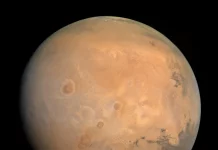
NASA’s rover, Curiosity, has made a fascinating find on Mars.
Imagine a dried up puddle with cracks all over.
That’s what the rover has found, but these aren’t just any cracks. These are ancient mud cracks that suggest Mars once had cycles of wet and dry periods, similar to Earth.
Why does this matter? Well, on Earth, it’s believed that life might have started due to such wet-dry cycles.
These cycles could help mix and form the basic chemicals needed for tiny living organisms. The hexagonal pattern of these cracks on Mars indicates there were repetitive wet-dry periods, possibly changing with seasons.
Curiosity is exploring Mount Sharp on Mars. On its journey, it found these mud cracks in a spot called “Pontours”.
This area is interesting because it’s between a layer filled with clay (which forms in water) and another layer that has a lot of salty minerals, which usually appears when water evaporates.
These different layers tell the story of Mars’ past. The presence of both clay and sulfates suggests that there were times when Mars was wet and times when it dried up.
When mud dries, it cracks. Curiosity had earlier found a place called “Old Soaker” with T-shaped mud cracks, indicating the mud dried once.
But in Pontours, the cracks are hexagonal. This suggests the area kept getting wet and then drying repeatedly. These patterns lasted even as new layers of mud settled on top. Curiosity also found a tough crust along the cracks which protected them from wearing away, allowing them to stay visible for billions of years.
One interesting tidbit is that Curiosity detected carbon in the mud, a key ingredient for life. However, it’s unclear if the conditions were right for life to start.
William Rapin, who led the study, mentioned this is the first real proof that Mars had consistent wet-dry periods like Earth. These cycles are crucial for creating molecules that are basic to life. Such conditions don’t just support life; they might help start it.
To explain further, life’s basic ingredients include carbon chains called polymers. These need specific conditions to form. Wet-dry cycles are like nature’s mixer, helping to balance the right amount of ingredients for these reactions. Sometimes, too much water can be a problem. But wet-dry cycles ensure that the chemical balance remains perfect for life’s ingredients to mix.
In over 11 years of exploration, Curiosity has found signs that ancient Mars could have been a place for tiny organisms. And now, this discovery suggests Mars might have also had the right conditions for life to begin.
What makes this even more special is that while Earth’s moving plates hide its ancient history, Mars, without such moving plates, has preserved its past. So, studying Mars can help us understand not just Mars, but maybe even Earth’s ancient secrets!
In short, thanks to Curiosity and NASA, we’ve got a hint that Mars might not just have had water, but also the perfect recipe to cook up life!
Note: Curiosity’s exciting adventure is led by NASA’s Jet Propulsion Laboratory in California.
Follow us on Twitter for more articles about this topic.



